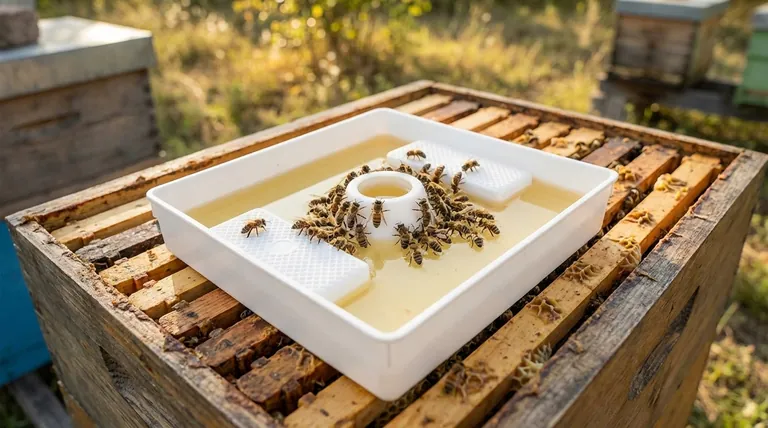In short, a honey bee feeder is a piece of beekeeping equipment designed to provide supplemental food to a honey bee colony. Beekeepers use them to supply sugar syrup, honey, or pollen substitutes when natural nectar and pollen sources are scarce, ensuring the hive has the nourishment it needs to survive and thrive.
A bee feeder is more than just a food dish; it's a critical management tool. Understanding that no single feeder is perfect is the first step—the right choice always depends on balancing the needs of your specific colony with the risks of drowning, robbing, and hive disruption.

Why Supplemental Feeding is a Critical Tool
The primary purpose of a feeder is to sustain a colony when it cannot sustain itself. A healthy hive's fate is directly tied to the availability of natural forage, which can be unpredictable.
Supporting a New Colony
Newly installed bee packages or nucs have a tremendous amount of work to do. A feeder provides a consistent energy source, allowing them to rapidly build comb, raise brood, and establish the hive.
Surviving Seasonal Gaps
Bees often face periods of "dearth," where few flowers are blooming. This is common in late fall before winter and in early spring before the first major nectar flow. Feeders bridge these nutritional gaps, preventing starvation.
Mitigating Environmental Factors
Droughts, extended periods of rain, or unseasonable cold can prevent bees from foraging. A feeder provides a reliable backup, ensuring the colony's survival through poor weather.
Key Factors in Choosing a Feeder
While many designs exist, from simple jars to complex internal systems, your decision should be based on a few core principles. A thoughtful choice will save you time and protect your bees.
Colony Size and Feeder Capacity
The feeder's volume must match the colony's needs. A small, new colony may only need a quart-sized feeder, while a large, established hive preparing for winter might require a feeder that holds a gallon or more to minimize refills.
Ease of Use and Hive Disruption
Every time you open a hive, you disrupt its internal environment and risk harming the bees. Choose a feeder that you can refill quickly and easily. External feeders are often easier to manage without disturbing the colony.
Bee Safety and Accessibility
A good feeder allows easy access to the food without endangering the bees. Drowning is a significant risk. Look for designs that include ladders, floats, or textured surfaces that allow bees to drink safely and climb out if they fall in.
Durability and Materials
Your feeder will be exposed to the elements and sticky sugar syrup. Opt for durable, easy-to-clean materials like BPA-free plastic or corrosion-resistant metal. This ensures a long service life and prevents contamination.
Understanding the Trade-offs
Every feeder type has inherent advantages and disadvantages. Acknowledging these compromises is key to making an informed decision.
The Risk of Robbing
Some feeder designs, particularly those placed at the hive entrance, can attract bees from other colonies. This "robbing" behavior can lead to a fight that devastates or destroys the weaker hive. Internal feeders generally offer better protection against this.
Internal vs. External Designs
Internal feeders are placed inside the hive, protecting the syrup from robbers and weather. However, they require you to open the hive for every refill, causing more disruption.
External feeders, like entrance feeders or mason jar feeders, are easy to monitor and refill. Their drawback is greater exposure to weather and a higher potential to incite robbing from nearby hives.
Making the Right Choice for Your Goal
Select your feeder based on your primary objective and beekeeping style.
- If your primary focus is simplicity for a new, small hive: A simple mason jar entrance feeder is an easy and inexpensive starting point.
- If your primary focus is feeding a large colony with minimal disruption: A high-capacity top feeder or frame feeder placed inside the hive is a more efficient choice.
- If your primary focus is maximizing bee safety: Choose a feeder with built-in ladders, floats, or a screened-off reservoir to prevent any chance of drowning.
Ultimately, a bee feeder is a tool that empowers you to be a more responsive and effective beekeeper.
Summary Table:
| Feeder Type | Best For | Key Considerations |
|---|---|---|
| Internal (e.g., Frame/Top Feeder) | Large colonies, minimizing robbing | Protects from weather/robbers; requires hive disruption to refill |
| External (e.g., Entrance/Mason Jar) | New/small colonies, ease of use | Easy to monitor/refill; higher risk of robbing and drowning |
Equip your apiary with the right tools for success. HONESTBEE supplies durable, bee-safe honey bee feeders and a full range of beekeeping supplies to commercial apiaries and distributors. Ensure your colonies thrive through every season—contact our experts today to discuss your wholesale needs!
Visual Guide

Related Products
- HONESTBEE Professional Hive Top Bee Feeder Feeding Solution
- HONESTBEE Entrance Bee Feeder Professional Hive Nutrition Solution for Beekeeping
- Rapid Bee Feeder White Plastic 2L Round Top Feeder for 8 or 10-Frame Bee Hives
- Professional Hive Top Bee Feeder for Beekeeping
- Professional Hive Front Entrance Bee Feeder
People Also Ask
- Do I need an inner cover with a hive top feeder? Optimize Your Hive Setup for Healthy Bees
- What should be done with feeders and equipment after feeding bees? Essential Steps for Apiary Health
- Why is a top feeder essential for bees? Ensure Colony Health and Efficiency
- How is the plywood floor fitted into the hive-top feeder? Ensure Longevity with a Floating Floor Design
- What are the advantages of hive top feeders? Maximize Feeding Efficiency for Your Apiary



















